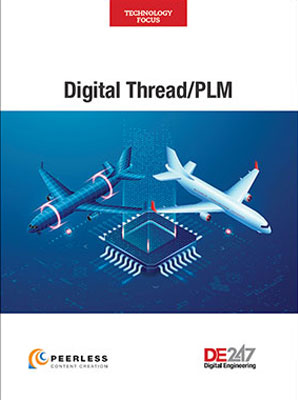How to Secure Your Digital Thread
Though digital threads benefit organizations, they also pose several security concerns.

Many manufacturing operations require integration of legacy systems with sophisticated digital technologies at different layers along the digital thread. Investments in upgrades should be informed by cost-benefit analysis and risk assessments aligned with company business models. Image courtesy of The Smart Factory @ Wichita and Deloitte Development LLC.
Latest News
October 21, 2022
Digital thread creation exposes companies to new security risks. These emerging communications infrastructures extend the limits of connectivity, shatter barriers that lock data into silos, access data from a diverse variety of systems, span all phases of the product lifecycle and reach beyond the boundaries of single companies.
In short, digital threads aim to create an unprecedented level of openness, which provides access to a vastly larger and more comprehensive pool of data.
But there’s a problem.
“End-to-end integration directly with operational and manufacturing environments introduces new threat vectors to what bad actors see as a treasure trove of data that they would not have had access to in less integrated environments,” says Veronica Lim, lead for the product security practice within the cybersecurity group at Deloitte. “In some cases, data that was previously maintained in disparate databases and systems is now part of fully automated supply chains that reach from sourcing to customer.”
Essentially, more openness creates vulnerabilities in additional vectors of attack. But while digital threads expose companies to cyber threats, the extent of the vulnerabilities depends on how an organization implements digitization.
“If you are mindful of security while building your digital thread, each new threat can be mitigated effectively,” says Rob McAveney, chief technology officer at Aras.

Countermeasures to security threats are as complex as the infrastructures they are designed to protect. Hotspots to address range from traditional weak points found in all types of connectivity infrastructures to vulnerabilities unique to digitization initiatives in general and to digital threads in particular. Mitigating these vulnerabilities requires companies to take advantage of the full range of security tools and practices (Fig. 1).
“It’s important to remember that there’s no silver bullet when it comes to cybersecurity,” says Oscar Ornelas, chief product security officer at PTC. “Companies need a thoughtful approach that crosses systems, tools, people and processes.”
Perils of Piecemeal Implementations
An initial challenge confronting a company securing its digital thread arises in the early stages of thread development and relates to how the digital thread is implemented.
Often, companies cultivating digital threads have already deployed some version of the systems that comprise the digital connectivity framework. As a result, a potential attack surface exists from the start, requiring cyber defenses to secure individual systems, often in a piecemeal process.
Complicating the situation, each individual system has its own security considerations, reflecting varying levels of technological maturity and different vendors’ proprietary systems.
The alternative to the piecemeal approach is to simultaneously deploy all systems comprising the digital thread. This approach promises to simplify implementation by mitigating integration-compatibility difficulties.
“Bringing all systems into a digital thread at the same time is more efficient and beneficial,” says Ornelas. “It allows companies to apply a more holistic security lens to all the systems working together, especially if the digital thread products are provided by a single company.”
Unfortunately, this approach has drawbacks. Companies may not have the resources to make a deployment of this scale, and it may be difficult to secure support for such a sweeping change without first testing the waters.

Even if these two issues do not come into play, companies must work through other dilemmas. For example, electing to deploy a single vendor’s security software may preclude access to best-in-class tools.
Number of Stakeholders Impacts Vulnerability
One of the greatest points of digital thread vulnerability lies in the ever-expanding scale of connectivity frameworks.
“As digital connections and interactions become more prevalent across a supply chain—striving for the concept of a comprehensive digital thread—the opportunities for infiltration increase,” says Steve Nichols, vice president and military technical lead at Razorleaf. “Particularly at risk are the connections among suppliers, where information is exchanged and avenues are opened to insert and remove information into and from the process.”
At issue is the potential for inconsistent security practices among various supply chain partners, which precludes a holistic defense because of lack of visibility into stakeholder processes and procedures. Combined, these factors create blind spots that can compromise digital thread security.
“A general lack of understanding about the security posture, general cybersecurity policies and overall security solutions of third-party vendors and providers poses a significant cybersecurity issue to many companies,” says Lim.
Though often it is not feasible to gain insight and access to partner networks to verify and validate security mechanisms, there are practices that can help digital thread managers mitigate these risks. For example, many companies audit vendors to ensure that they are meeting security requirements set forth in contracts and verify how their partners store, access, use and secure data.
In addition to vendor oversight practices, companies can secure digital threads with advanced methods that involve manipulating the design or manufacturing data that third parties store and process. These techniques include anonymization and nonattribution practices.
A strong program of controls at every stage of the design and manufacturing processes considerably mitigates cyber risk. Establishing these controls to secure longer digital threads can be a challenge because of the cost of implementing some of these measures.
Ensuring Cloud Security
The inclusion of cloud in digital threads can also create vulnerabilities to cyber threats if appropriate security procedures are not created. The company implementing the digital thread must monitor the cloud platform’s security measures similar to how it manages its supply chain partners.
This process should begin by ensuring that the entry point between the two organizations does not become an exploitable opening.
“At the most basic level, the use of secure and encrypted communications, such as HTTPS and a VPN, provide a hardened data path,” says Jonathan Scott, chief architect at Razorleaf. “The use of multifactor authentication also protects remote sessions.”
A company should verify that the cloud’s cyber defense meets the unique requirements of its digital thread. Companies should monitor the details of security and service agreements, confirming visibility and cultivating a concise understanding of the cloud provider’s practices.
Complicating this process is the overwhelming number of tools available for the cloud. What is selected should support the specific needs, use cases and integration with existing design or manufacturing management platforms.
“Companies considering cloud providers should start with their vendor risk management programs,” says Matt Hart, chief information security officer at PTC. “When working with a cloud provider, companies should be looking for baseline best-in-class security practices. These include diligent access management, strong encryption practices, 24/7 monitoring and software patching, to name a few.
“If IP is leaving a company’s cloud, it should ensure there is traceability and audit log management,” Hart adds. “This helps a company understand who has access to the data as it’s being shared, which can be especially important when a product company is working with third parties like contract manufacturers.”
Problem with Legacy Systems
A vulnerability that almost all companies must face when securing their digital thread revolves around shortcomings of legacy machines and software. Many systems simply weren’t designed to take advantage of digital technology, and without the muscle provided by digitization, legacy systems cannot stand up to the cyber threats prevalent today.
“Many manufacturing systems will require integration of legacy systems with more mature technologies at different layers along the digital thread,” says Lim. “Legacy systems often cannot support cutting-edge controls and, in some circumstances, may become the weakest link in the security chain.”
These weaknesses often manifest as an inability to secure communications. For instance, legacy systems often cannot communicate over encrypted channels. Without recourse to digital technology, communications are visible in plain text, and systems may lack the ability to authenticate users.
These limitations play out in many different ways, but the bottom line is that these all pose vulnerabilities to the digital thread.
Software constantly changes, improves and receives updates. Software vendors, however, support their products for only so long, and even when vendor support is still available, many legacy systems cannot receive over-the-air updates to address security vulnerabilities.
“By keeping legacy tools, with outdated software and firmware as part of the digital thread, the opportunity for vulnerabilities to be exploited increases,” says Scott. “This puts the entire data fabric at risk.”
Another example of security risks stemming from legacy systems’ inability to take advantage of digital technology can be seen where legacy tools create a path for an attack through sustainment activities via the Internet of Things (IoT).
“As the digital thread becomes more comprehensive and starts to include data from products during their use, the opportunity exists for data to be inserted into the inbound IoT stream and, if utilized, the outbound IoT stream, to alter the digital thread in unanticipated ways,” says Scott. “This would be similar to the SolarWinds attack, which exploited the software update process.”
One way to prevent someone from taking over a machine and using it as a launching point for an attack is to isolate communications of that system in ways that mitigate the risk.
“You may not be able to send encrypted messages directly to a legacy machine, but you can isolate the machine behind a device that filters and encrypts its payload before being sent across the network,” says McAveney. “Companies should never let the presence of legacy equipment hold them back. There are well-established patterns to connect them securely.”
At some point, manufacturers and product companies will have to modernize their facilities. During the upgrade process, they should be sure to make security a major consideration (Fig. 2).
“When companies undertake modernization efforts, they should invest in technology that is considered futureproof and allows them to make security changes at a scalable level instead of in one-off instances,” says Hart.
Building a Successful Defense
As intimidating as the security challenge may be, companies can build secure digital threads. The key to success is to give security careful consideration at every step of the implementation process.
“What makes a digital thread secure is constant vigilance in how you approach every technology decision,” says McAveney. “Every time you add something new to the thread, you must consider security. Every decision you make should take security into account. There’s always a place for penetration testing tools and code scans that detect software vulnerabilities.”
Ultimately, however, security is implemented through process. Exposing data to other departments or companies is not the decision of an individual. It’s a formal process with proper governance. Breakdowns in process create vulnerabilities. Technology can help, but nothing can be secured by technological means alone.
“The digital thread is secured by ensuring that the tooling follows security best practices, not by buying yet another tool to create the security,” says McAveney. “A reactive approach to detecting vulnerabilities and intrusions only notifies you after a breach occurs. What makes a digital thread secure is constant vigilance in how you approach every technology decision.”
Following these protocols, however, does not preclude the novel use of emerging technologies.
“One technology to consider for protecting the dataflow is blockchain or a similar type of data security application,” says Razorleaf’s Nichols. “Blockchain covers a wide range of transactions, including financial, medical and supply chains. Because a digital thread can be modeled as a virtual supply chain, applying blockchain capabilities would provide a level of security to the flow of data between secured environments. Blockchain, combined with data encryption, would harden both the data and its content against interception and modification, providing a record of the data heredity for future verification and validation.”
Ultimately, a diverse combination of applications, tools and training are critical for a successful defense of the digital thread. Training and robust user access policies will be key foundations of the security program and should not be overlooked when planning the overall security of the thread.
More Aras Coverage
More PTC Coverage
Subscribe to our FREE magazine, FREE email newsletters or both!
Latest News
About the Author
Tom Kevan is a freelance writer/editor specializing in engineering and communications technology. Contact him via .(JavaScript must be enabled to view this email address).
Follow DERelated Topics







